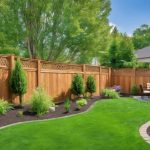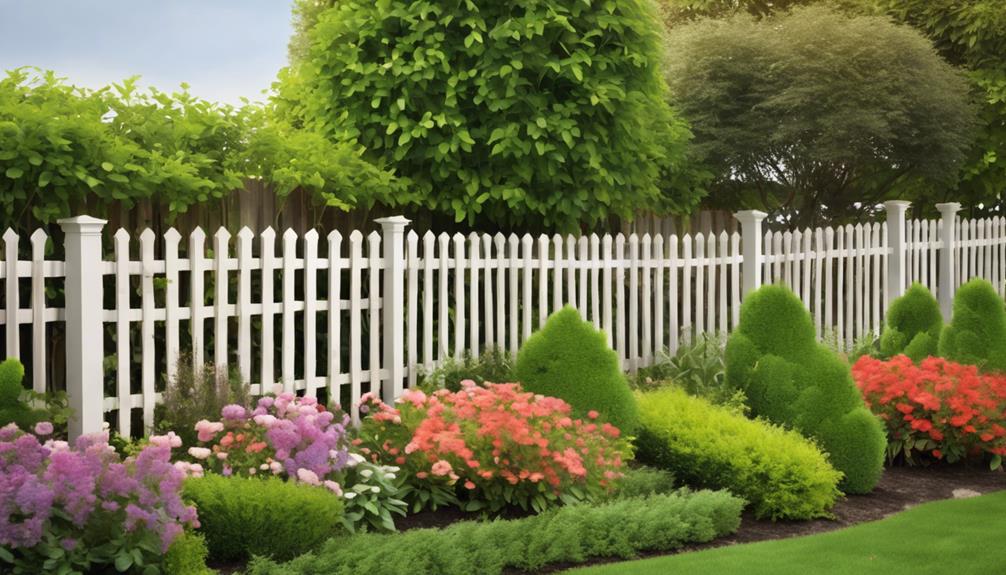
Common Garden Design Mistakes Beginners Make
18 September 2024
10 Best Affordable Garden Fencing Installers Near You
19 September 2024The top three fencing options for garden privacy include wood, vinyl, and metal fencing.
Wood offers a natural aesthetic and customizable designs, although it requires regular maintenance.
Vinyl fencing, while initially more expensive, is low-maintenance and moisture-resistant, boasting a lifespan of up to 30 years.
Metal fencing, such as aluminium or wrought iron, provides durability and strength, often lasting over 50 years with minimal upkeep.
Each material presents distinct advantages regarding aesthetics and functionality, enhancing both privacy and property value.
For a comprehensive understanding of these fencing options, consider exploring further insights and recommendations.
Garden Fencing Types Explained
When considering garden fencing options, understanding the advantages of wooden fencing and the durability of metal fencing is crucial.
Wooden fences offer aesthetic appeal and natural insulation, making them a popular choice for privacy.
In contrast, metal fences provide long-lasting strength and resistance to weather elements, ensuring they withstand the test of time.
Wooden Fencing Advantages
Wooden fencing offers homeowners a blend of aesthetic appeal and practical benefits, making it a popular choice for garden privacy.
One of the primary advantages of wooden fencing is its versatility in design; it can be customised to suit different architectural styles and personal preferences. In addition, wood provides excellent sound insulation, creating a tranquil environment.
Its natural appearance harmonises beautifully with garden landscapes, enhancing the overall visual appeal. Moreover, wooden fences are environmentally friendly, particularly when sourced sustainably, and they can be treated for longevity.
Maintenance is relatively straightforward, with options for staining or painting to match seasonal aesthetics.
All in all, wooden fencing combines beauty, functionality, and sustainability, making it an ideal option for discerning homeowners seeking privacy in their gardens.
Metal Fencing Durability
Metal fencing stands as a robust choice for homeowners prioritising durability in their garden privacy solutions. Constructed from materials such as aluminium, wrought iron, or steel, metal fences offer exceptional resistance to environmental stresses, including moisture, pests, and extreme temperatures.
Unlike wood, metal does not warp, crack, or rot, ensuring longevity with minimal maintenance. Furthermore, many metal fencing options come with protective coatings that improve resistance to rust and corrosion, further extending their lifespan.
This enduring quality makes metal fencing a sound investment, providing not only security but also aesthetic appeal. With a range of designs available, homeowners can achieve both functionality and elegance, making metal fencing an ideal selection for those seeking steadfast privacy solutions in their gardens.
Design and Material Selection
When selecting fencing for garden privacy, it is essential to consider the durability of materials against various weather elements, ensuring longevity and minimal maintenance.
Aesthetic appeal also plays a significant role, as the right design can enhance the overall landscape while providing seclusion.
Furthermore, certain fencing options offer noise reduction features, contributing to a more tranquil outdoor environment.
Durability Against Weather Elements
Selecting the appropriate materials for fencing is crucial to ensure durability against various weather elements, which can significantly affect the longevity and appearance of your garden privacy solution.
To ensure your fencing withstands the test of time, consider the following factors:
- Material Resistance: Opt for materials such as vinyl or treated timber, which resist rot, corrosion, and fading.
- Weatherproofing: Ensure that the chosen material has undergone weatherproofing processes, such as UV treatment or water sealing, to enhance performance.
- Maintenance Requirements: Select options that require minimal upkeep over time, allowing for long-term durability without extensive care.
Aesthetic Appeal of Fencing
In enhancing the aesthetic appeal of garden fencing, thoughtful design and material selection play a pivotal role. Choosing the right combination can transform a functional boundary into a visual focal point.
To achieve this, consider the following elements:
- Material Variety: Opt for materials that complement your garden style, such as natural wood for a rustic feel or sleek metal for a modern aesthetic.
- Colour and Finish: Select colours that harmonise with existing landscaping. A well-chosen stain or paint can enhance the visual depth and character of the fence.
- Design Features: Incorporate decorative elements such as lattice tops, post caps, or decorative panels to add sophistication and personalise the fencing.
These considerations ensure that your garden fencing is not only practical but also enhances the overall landscape design.
Noise Reduction Features
Reducing noise intrusion in garden spaces requires careful evaluation of fencing design and material selection. Effective noise reduction can greatly improve the tranquillity of outdoor environments.
Here are three key factors to consider:
- Material Density: Heavier materials, such as concrete or thick timber, provide superior sound insulation compared to lighter options such as vinyl or chain-link.
- Height and Thickness: Taller and thicker fences create more barriers against sound waves, thereby reducing noise penetration into your garden.
- Design Features: Solid panels or overlapping boards minimise gaps, preventing sound from travelling through openings, while irregular designs can further disrupt sound waves.
Installation Tools and Materials
Before commencing your fencing project, it is essential to gather all necessary tools to ensure a smooth installation process.
Proper measurement of post depth is critical for structural integrity, while exploring creative fencing patterns can enhance both functionality and aesthetics.
Gather Your Tools First
How can you ensure a smooth installation process for your garden fencing? The key lies in adequately preparing your tools and materials in advance.
A well-organised workspace can significantly enhance your efficiency and precision during installation.
Here's a concise list of essential tools and materials you should gather:
- Post Hole Digger: Crucial for creating deep, stable holes for your fence posts.
- Level: Ensures your fence is perfectly vertical, which is essential for both aesthetics and durability.
- Concrete Mix: Provides a solid foundation for your posts, preventing future sagging or instability.
Proper Post Depth Measurement
Achieving the correct post depth is critical for guaranteeing the stability and longevity of your garden fencing. A well-placed fence post can withstand environmental stressors and maintain structural integrity.
To measure post depth accurately, consider these crucial steps:
- Determine Frost Line: Identify your local frost line, which typically ranges from 60 to 120 centimetres, depending on your geographical location, as this will influence the minimum depth needed.
- Use a Measuring Tool: A post-hole digger or auger will allow you to achieve precise depth measurements; ensure the tool is vertical for accuracy.
- Check with a Level: After placing the post, use a level to confirm it is plumb before securing it with concrete or soil.
Mastering these techniques will greatly improve your fencing project.
Creative Fencing Patterns
Once the fence posts are securely in place, the next step involves exploring creative fencing patterns that can enhance both functionality and aesthetic appeal.
Cutting-edge designs not only improve privacy but also contribute to the overall landscape.
Consider the following patterns:
- Lattice Design: Interwoven slats create an elegant, semi-transparent barrier, allowing light while maintaining privacy.
- Chevron Pattern: Alternating angled boards add visual interest and depth, making the fence a focal point of the garden.
- Vertical and Horizontal Mix: Combining vertical and horizontal elements can produce a modern, dynamic look, effectively breaking up the monotony.
Utilising these patterns can transform your fencing project into an artistic statement, elevating the garden's overall charm while ensuring the necessary seclusion.
Increased Property Value
Increasingly, homeowners recognise that investing in quality fencing can significantly enhance property value. A well-constructed fence not only elevates aesthetic appeal but also provides security and privacy—key factors that prospective buyers prioritise.
| Fencing Material | Cost Range | Value Increase |
|---|---|---|
| Wood | £15-£30/ft | 10-15% |
| Vinyl | £20-£40/ft | 15-20% |
| Aluminium | £30-£50/ft | 5-10% |
| Chain Link | £10-£20/ft | Minimal |
| Composite | £25-£45/ft | 10-15% |
Selecting the right fencing option can yield significant financial benefits upon resale, making it a strategic enhancement for any property. Homeowners should evaluate their fencing choices with a focus on long-term value appreciation.
Garden Design Enhancement Techniques
Incorporating design elements such as vertical gardens, trellises for climbing plants, and hanging planters can significantly enhance both the aesthetic and privacy of your garden space.
These techniques not only optimise the use of vertical space but also create a lush, green backdrop that complements fencing options.
Vertical Garden Integration
Integrating vertical gardens into your landscape design not only enhances aesthetic appeal but also serves as an effective solution for privacy concerns. By strategically placing vertical gardens, you can create natural barriers that improve your space while offering seclusion.
Consider the following techniques for ideal integration:
- Layered Planting: Utilise varying heights to create depth and visual interest, ensuring a dense coverage that shields your garden from prying eyes.
- Seasonal Variation: Select a mix of perennial and annual plants to maintain greenery throughout the year, providing ongoing privacy while showcasing seasonal beauty.
- Structural Support: Employ sturdy frameworks that not only support plant growth but also define garden boundaries, reinforcing the aspect of privacy.
Vertical Trellis for Climbing Plants
Vertical trellises serve as an excellent complement to vertical gardens, offering supplementary structure and support for climbing plants while enhancing garden design.
These trellises not only provide verticality but also create a lush, green backdrop that increases privacy and visual appeal.
To effectively utilise vertical trellises, consider the following techniques:
- Choose the Right Climbers: Select plants that thrive in your climate and are suited for trellising, such as clematis or climbing roses.
- Proper Placement: Position trellises strategically to optimise sunlight exposure and create natural barriers against prying eyes.
- Maintenance Practices: Regularly prune and train plants to ensure they remain healthy, dense, and aesthetically pleasing.
Incorporating these elements will enhance your garden's privacy and overall design sophistication.
Hanging Planters for Privacy
Hanging planters provide a distinctive solution for enhancing garden privacy while adding aesthetic value to outdoor spaces.
These versatile elements can create a visually appealing barrier, allowing for both seclusion and style. To effectively utilise hanging planters for privacy, consider the following techniques:
- Layered Heights: Arrange planters at varying heights to create a dynamic visual effect that obscures sightlines.
- Dense Foliage: Select plants with lush, dense foliage to optimise the blocking effect, including varieties such as ferns or trailing ivy.
- Strategic Placement: Position hanging planters near fences or walls to reinforce privacy while creating a verdant backdrop.
Incorporating these techniques not only improves privacy but also transforms your garden into a serene retreat, encouraging relaxation and enjoyment of your outdoor space.
Installation Timing Issues
When planning the installation of garden fencing, timing is critical, particularly in relation to weather conditions.
Selecting weather-resistant materials ensures durability and longevity, while implementing wind resistance strategies can mitigate potential damage during storms.
Weather-Resistant Materials Selection
Selecting weather-resistant materials for garden fencing is crucial to ensure longevity and maintain aesthetic appeal. Choosing the right materials can significantly reduce maintenance costs and enhance durability against the elements.
Consider the following options:
- Vinyl Fencing: This material is impervious to moisture, preventing rot and decay, making it an excellent choice for a variety of climates.
- Composite Fencing: Comprising wood fibres and recycled plastic, composite options offer the beauty of wood while resisting warping and splintering.
- Metal Fencing: Galvanised or powder-coated metals provide superior resistance to rust and corrosion, ensuring a robust and long-lasting barrier.
Wind Resistance Strategies
To ensure optimal wind resistance in garden fencing, careful consideration of installation timing is essential.
Choosing the right moment to install your fencing can significantly enhance its durability against strong winds. Consider the following strategies:
- Seasonal Awareness: Install fencing during dry seasons to prevent soil displacement and secure stability as the ground settles.
- Weather Forecasting: Avoid installation immediately before predicted storms or high winds, as this can compromise structural integrity and alignment.
- Soil Conditions: Assess soil moisture levels; installing in excessively wet conditions can lead to compromised post stability and increased vulnerability to wind damage.
Wind-Resistant Fencing Techniques
How can one enhance the effectiveness of wind-resistant fencing techniques? Proper installation timing is crucial for maximising the durability and performance of your fencing. Here are three key considerations:
- Seasonal Timing: Install fencing during mild weather conditions. Avoid extreme temperatures and wet seasons, as these can compromise the integrity of the materials.
- Soil Preparation: Ensure that the soil is adequately dry and stable before installation. Wet or loose soil can lead to instability and reduced resistance to wind forces.
- Structural Support: Employ additional bracing and anchoring techniques, particularly in areas prone to high winds. Reinforced posts and tensioned cables can significantly improve the overall strength of the fence.
Why Choose TKL Birmingham Gardener
Choosing the right gardening service can significantly impact the aesthetic and functionality of your outdoor space, which is why TKL Birmingham Gardener stands out as a premier option.
With a commitment to excellence, TKL offers tailored solutions that enhance garden privacy through expert fencing installation and maintenance. Their team comprises seasoned professionals adept at understanding client needs, ensuring that every design aligns with the unique character of your garden.
Utilising high-quality materials and innovative techniques, TKL guarantees durability and visual appeal. Furthermore, their emphasis on sustainable practices not only promotes environmental stewardship but also fosters healthier landscapes.
Common Garden Fencing Questions
When considering garden fencing, clarity often emerges through addressing common questions that homeowners may have.
One frequent inquiry pertains to the ideal height of a fence for privacy; typically, a height of six to eight feet is recommended to effectively conceal your garden from prying eyes.
Another common concern involves materials; wood, vinyl, and metal each offer distinct benefits and aesthetics, requiring careful consideration based on durability, maintenance, and budget.
Furthermore, homeowners often ask about zoning laws and regulations, which can dictate fence height and placement. Understanding these guidelines is essential for ensuring compliance and avoiding potential disputes.
Finalizing Your Fencing Choice
Many homeowners find that finalising their fencing choice involves careful consideration of multiple factors that align with their specific needs and preferences.
The decision-making process can be streamlined by focusing on three critical elements:
- Material Durability: Assess how different materials withstand weather conditions and pests, ensuring longevity.
- Aesthetic Appeal: Consider how the fencing integrates with the overall landscape design and complements existing structures.
- Budget Constraints: Establish a clear budget that encompasses not just the initial cost but also maintenance and long-term investment.




